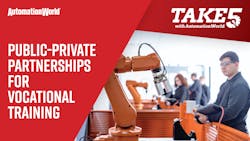
Quick hits:
- Deloitte projects 2.4 million manufacturing positions will go unfilled in the next decade.
- As a result of the shared interests held by private corporations, workers, local and state governments, and educational institutions, public-private partnerships are becoming more common to remedy this issue.
- Manufacturing is a demand multiplier. According to a 2019 analysis conducted by the Economic Policy Institute, whereas the loss of 1,000 jobs from a retail shopping mall could reverberate into 1,221 other job losses up and down the supply chain, the loss of the same 1,000 jobs from a manufacturing operation could result in the indirect loss of 7,441 jobs.
- Four-year University education often carries a heavy debt-burden, with extreme student loan delinquencies representing 35% of severe derogatories—more than credit cards, auto loans, or mortgages.
- Rockwell Automation and Cisco partner on New Manufacturing Training Program
- Fanuc and Rockwell Automation Create Apprenticeship Coalition
Hello and welcome to Take Five with Automation World. I’m David Miller, Senior Technical Writer for Automation World. Today, I want to talk about a specific aspect of the skills gap, and how remote access and augmented reality technologies can help companies to navigate it.
Today, I’m going to be talking about how public-private partnerships that mutually benefit all parties involved can help to improve the availability of vocational and technical training for careers in manufacturing.
Now, the first thing to note here is something you’ve probably heard a dozen times before, but we’ll say it briefly one more time. There is currently a tremendous skills gap in manufacturing with Deloitte projecting 2.4 million positions will go unfilled in the next decade.
But what can actually be done through the U.S. Educational system that will help to remedy this? Well, many feel that it starts with bolstering technical and vocational training opportunities – This refers to programs that take two years or less and allow workers to get certifications of various sorts that allow them to perform Middle-Skilled trade jobs such as welding or CNC machine operation, and so on. And if you talk to people, they will tell you that there are not enough programs of this sort within the U.S., which has perhaps over-emphasized four-year university education.
Now, this has to change at some point in time, because basically everyone wants more manufacturing in the U.S., and everyone has something to gain from it. Local and State governments want to drive business to their regions to drive economic growth. Manufacturing is what we call a demand multiplier – And what that means is because it’s so capital intensive and because the wages and salaries paid out are usually pretty high, every manufacturing job created supported a slough of others. This also expands the tax base, which is also something governments are strongly incentivized to do.
From the workers perspective, the benefit is clear – It’s a high paying job that’s also interesting and fulfilling with many opportunities for mobility and advancement, particularly as technology evolves, and it often doesn’t require them to take out the debt that a 4-year university education would.
The manufacturers themselves want well-trained, talented, and dedicated workers, and of course local colleges who provide training of various sorts want to bolster their credibility by training workers and being able to prove there is a pipeline between their institution and employment -- otherwise people might be skeptical as to whether attending is worth it.
So, one of the strengths of these arrangements is actually that they vary from region to region based on particular needs and circumstances, but in general, here’s how they work.
An educational institution such as a community college that is seeking to create a program will receive some form of grant funding from a local or state government to start it up, building facilities, hiring the proper faculty, and whatnot – The government will usually happily do this, of course, because it’s expecting a return on investment in the form of drawing companies to the region, nurturing economic growth, and therefore generating tax revenue. On the other side of that, companies who want workers – because they also have a need – will donate equipment for students at the college to train on.
This is also vital because these companies want workers who know how to use their specific equipment which may feature proprietary or otherwise vendor-specific functionality of some sort. So you have the local government making a wise investment to nurture talent bring business to the region, you have the college attaining resources it otherwise would not have access too, and you have the company ensuring that the workforce knows how to use its own particular equipment as soon as they come in the door. And of course, the workers are winning too, in that they have an opportunity to begin a career without taking out the often colossal debt that a four-year university education requires.
I actually spoke to some recently who works in educational outreach for a large industrial company, and she went as far to say that she had never seen a manufacturing training initiative work when all three of these stakeholders – government, the private sector, and educational institutions – did not work in tandem with one another. And so as the U.S. seeks to mend its skills gap, you can expect these kinds of partnerships to continue to be vital.
That’s all I have for you today, but if you enjoyed this video, stay tuned for more to common in the days ahead.
